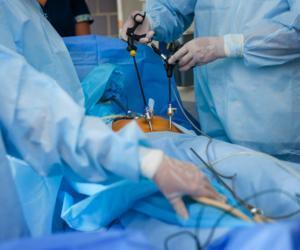What Are the Different Types of Hysterectomies?
There are surgical techniques that make a hysterectomy less painful and more easily recovered from.

Removing the womb or uterus surgically has always been an option for women troubled by severe bleeding, uncontrolled fibroid growth, painful endometriosis, and spreading cancer. Removing the source of the problem has been considered the best remedy for relieving these painful symptoms that extensively and frequently trouble women suffering these conditions.
Till recently, the traditional abdominal hysterectomy was considered the go-to surgical solution for general surgeons and gynecologists because of the ease and lack of complexity of the procedure. All this changed with the advent of laparoscopic hysterectomy. Here is a brief overview of the different kinds of hysterectomy procedures and their relative merits and drawbacks:
1. The Abdominal Approach
This is the traditional method that gynecologists and general surgeons resort to when the uterus is removed in its entirety along with other organs such as the cervix, ovaries, or fallopian tubes. Unknown to many women, however, abdominal surgery is only one among a number of surgical options for uterus removal. The other options, in fact, are less invasive and involve less pain.
Abdominal Surgery Becomes Necessary When the Following Complications Have Arisen:
- The uterus has become too enlarged due to uncontrolled fibroid growth. Fibroids tend to stretch and solidify the uterine wall, causing immense pelvic discomfort to women.
- The ovaries, fallopian tubes, or cervix may have become cancerous, and all associated reproductive organs may need to be surgically removed to stop the cancer from proliferating.
- Lab tests and ultrasound screening have confirmed the growth of endometrial tissue outside the uterine cavity, projecting into the pelvic cavity. This is potentially damaging for organs adjacent to the reproductive system in the pelvic region.
- The urinary bladder or the colon may have become attached to the uterus, forming scar tissue that eventually affects the functioning of these organs. If the condition is not corrected, involuntary voiding of urine and feces may result.
The Surgeon Enjoys Easier Access and Better Comfort
An abdominal hysterectomy enables the surgeon to repair anatomical problems in the pelvic area quickly and decisively. The operation takes around two hours and is performed while keeping the patient under sedation and anesthesia (either general or spinal).
Ailments Specific to the Patient Will Decide Whether a Hysterectomy Will Be Total or Partial
The major preoperative discussion would center on removing the ovaries, fallopian tubes, and cervix. The emphasis will always be on preserving organs that have a lower potential for deepening discomfort.
Hormone Replacement Therapy Will Be Necessary if Ovaries Are Removed
Removing ovaries will impact hormone release and create hormone imbalances triggering the onset of menopause, and the advantages and disadvantages of hormone replacement therapy will need to be considered.
Chronic Ailments Can Complicate Abdominal Surgery and Post-Surgical Recovery
Recovering from an abdominal hysterectomy is time-consuming, and preexisting ailments such as diabetes and heart disease may delay recovery, making it necessary to keep the patient under intensive care and close observation before, during, and after the operation.
Sex Drive and Sexual Performance Will Be Enhanced
An abdominal hysterectomy does not diminish the woman’s sex drive, feelings, or performance in any manner, and in the majority of cases, women actually report improvement once pain and bleeding are halted.
Abdominal Scarring May Become an Issue
There is no way of avoiding abdominal scars as the surgical incisions are larger, and for this reason, many women opt for less invasive surgical options such as a vaginal hysterectomy or laparoscopic surgery.
2. The Vaginal Surgical Route
One way of avoiding surgical scarring on the abdomen is by making a minor incision in the upper wall of the vaginal passage in order to reach the uterus. For the patient, the vaginal surgical route creates less discomfort and pain, and recovery is also speeded up.
In a bilateral salpingo-oophorectomy, both the ovaries and fallopian tubes are removed through the vaginal passage. In a bilateral salpingectomy, the surgeon removes only the fallopian tubes by severing the points where the tubular structures connect to the upper portion (fundus) of the uterus.
Compared with an abdominal hysterectomy, a vaginal hysterectomy poses fewer complications, enables faster recovery on account of the simpler surgical procedure, and does not scar the patient. The main condition prompting vaginal surgery is excessive bleeding from the uterus called Menorrhagia. In this condition, the patient suffers prolonged blood loss for periods exceeding six days at a time, requiring the changing of sanitary pads on an hourly basis. A vaginal hysterectomy becomes the last resort when medication and alternative therapies fail to stem the bleeding.
A Vaginal Hysterectomy is Usually Recommended in the Following Circumstances:
- When fibroid growths provoke excessive and uncontrollable blood loss.
- When the uterus is small enough to allow its removal through the vagina, or when a larger uterus can be morcellated (shredded) and sucked out through the vaginal incision.
- If endometriosis or widespread scarring of organs is not indicated, especially after previous operations.
- If cancer is not detected, and the possibility of infection in the peritoneum can be ruled out.
The operation requires at least two hours with the patient placed under general or spinal anesthesia and completely sedated. Post-surgical risks cannot be ruled out in vaginal surgery, and the surgeon needs a very good skill profile for operating without complications. Usually, an experienced gynecologist performs the surgery, making way for a gynecological oncologist if cancer is detected in the reproductive system. The patient's age and history of medical problems will determine the period of stay in the hospital after a vaginal hysterectomy.
3. Laparoscopic Hysterectomy
This is a variation of abdominal surgery but performed with highly-advanced surgical tools requiring smaller incisions, usually three in number. The procedure uses a laparoscope, which enables three-dimensional observation of the organs while specialized tools manipulate the tissue.
Also Called Keyhole Surgery, the Patient Benefits in Several Ways:
- The patient lies longer on the operating table but recovers faster, enabling admission and hospital discharge on the same day.
- Significantly less bleeding, fewer technical hitches, lower chances of acquiring infections, and minimal abdominal scarring result from this procedure.
- The laparoscopic surgeon is specially trained to operate with minimized risk to the adjoining organs in the pelvic cavity. This is significant as the urinary bladder, ureters, colon, and rectum are more likely to be injured in other hysterectomies.
- A larger uterus can be shredded and sucked out using laparoscopic tubes, though this procedure is not advised when cancer is detected.
- Laparoscopic surgery lowers the risk of damage to the supporting structures and muscles of the pelvic area, one of the main reasons why recovery is faster in such patients.
Robot-Assisted Laparoscopic Surgery
This revolutionary technique is making waves in the medical field because it speeds up operations and reduces human error, which complicates surgery. Its biggest advantage is a clearer image of the abdominal cavity and pelvic organs. This enables the surgeon to perform complex tissue dissection that can be fine-tuned to avoid peripheral damage to nerves and blood vessels. Through robotic surgery, gynecological oncologists are in a better position to perform sensitive operations that target cancerous cells with the least damage to healthy tissue.
The latest generational change in surgical robots and robotic appendages has made it possible for surgeons of all skill levels to perform basic gynecological surgery with greater accuracy in a minimally intrusive way. Laparoscopic surgery and all its attendant technological advances have made it possible to redefine patient comfort and improve post-surgical recovery.











